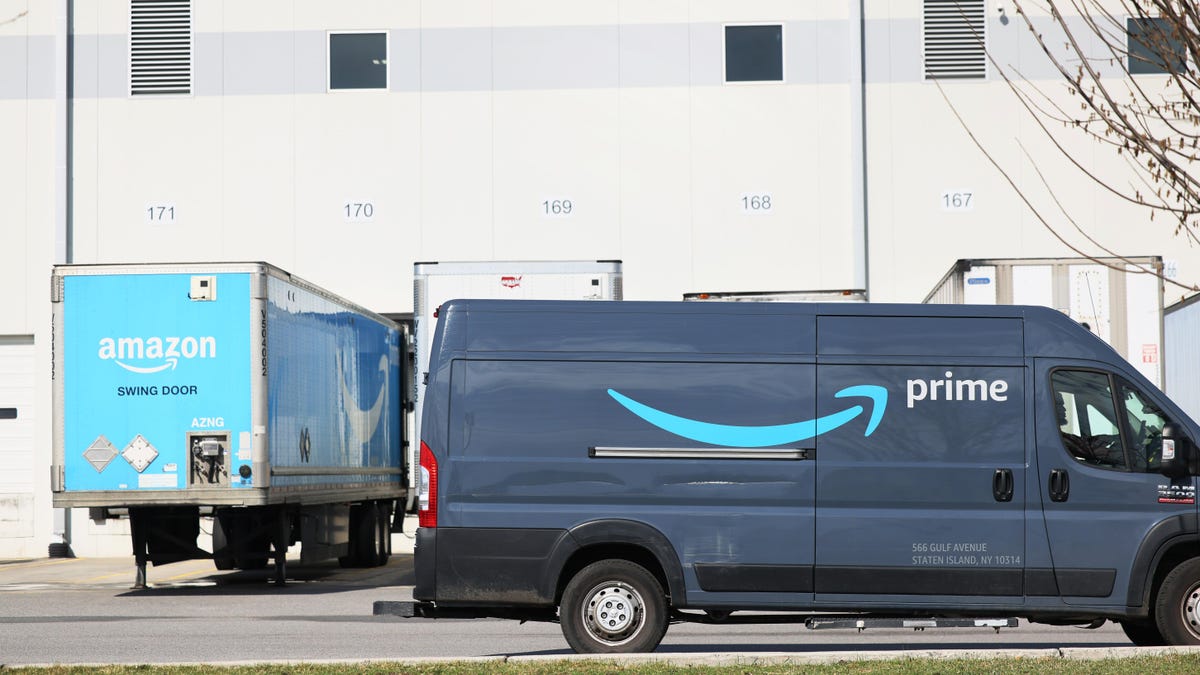Amazon Hires Some of the Most Dangerous Trucking Contractors in the U.S.: Report

An Amazon delivery truck drives past Amazon’s JFK8 Staten Island fulfillment center in Staten Island on March 25, 2022 in New York City. (Photo: Michael M. Santiago (Getty Images)
When Amazon isn’t torturing employees or being complicit in people being detained and repatriated by Homeland Security, it’s helping make our deadly roads become even less safe.
A new deep dive from the Wall Street Journal details a disturbing trend among the trucking contractors Amazon hires to haul some of the around 1.6 million packages the company sends out every month. Reporters found that the Department of Transportation rated trucking companies that frequently contracted with Amazon with unsafe driving scores more than twice as much as similar trucking companies.
Of course, Amazon disagrees with these findings but it sure seems like the WSJ did its homework:
The Journal’s analysis focused on 3,512 trucking companies that were inspected by authorities three or more times while hauling trailers for Amazon since February 2020. That group carried 75% of Amazon tractor-trailer shipments documented in records of government inspections, which include routine compliance checks, such as at weigh stations, and traffic stops.
[…]
The data show companies that “frequently haul Amazon’s freight are systematically more likely to have poor driving safety scores,” said Jason Miller, a Michigan State University professor who studies transportation safety and validated the Journal’s methodology and findings. The result, he said, is that “American motorists are put at greater risk.” (See related story for the Journal’s full methodology.)
Aspects of Amazon’s delivery network have come under scrutiny from news organizations including the Information, the New York Times and ProPublica. The Journal’s analysis for the first time showed how the safety performance of Amazon’s trucking contractors compared with their peers.
The WSJ found evidence that Amazon continued to use unsafe trucking contractors, even after the date the company said contracts were canceled. It’s not like these crashes haven’t left damage in their wake. One story recounted in the piece ends with a one-year-old’s death and the paralyzing of his 3-year-old brother. An Amazon truck crash took a motorcyclist’s leg in 2021. Meanwhile, Amazon says it put in place requirements that driving safety scores be above the national average for its feet back in February.
And this isn’t an industry-wide phenomenon by any means. UPS, for example, keeps violations, such as false logs of driving hours, down to maybe one in every one thousand logs. Amazon’s contract drivers were dinged 70 times more for the same infraction. Strict delivery times and contractors getting paid by the mile rather than a salary like UPS drivers, contributes to the culture of unsafe driving, but it’s not the whole story. For instance, the New York Times rang alarm bells about Amazon drivers back in 2019 however. It sure doesn’t seem like safety is all that hight on the priorities list for Amazon drivers. What else can we expect from a company that just last year was caught telling its drivers to turn off a safety-tracking app in order to complete deliveries in a more timely (and dangerous) fashion.
G/O Media may get a commission
First Bag Free
Atlas Coffee Club – Free Coffee
Explore global coffee
With each bag, Atlas includes details on the coffee’s tasting notes and a postcard about the region and its coffee history. And when you subscribe, you have options to tailor frequency, grind size, and roast preference of your beans, so you’ll always be brewing the perfect cup.
The Journal cooked up some very useful visuals to help readers grasp the actual enormity of the problem, so give it a look right here.



